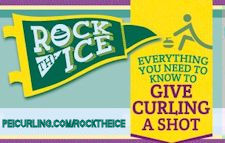For more perspective on the new Relegation/”Play-in” format, here’s yesterday’s edition of Jim Morris’ column, “A Little More” in the CCA-sponsored “Tankard Times”, the daily newspaper at the 2014 Tim Hortons Brier in Kamloops, BC.

There once was a time when games at the Brier lasted 12 ends, people used corn brooms and the sweaters hung down to the players’ knees. People also smoked on the ice. Times have changed. Players now sweep with brushes, games are 10 ends and there is the free-guard rule. No one smokes.
Some of these changes were initially met with resistance but most people agree the game has improved.
Canadian curling will undergo another evolution next season when Team Canada is added to the Tim Hortons Brier in Calgary and Northern Ontario is included at the Scotties Tournament of Hearts at Moose Jaw, Sask. Both the Brier and Scotties will also see a play-in system introduced.
In some quarters these revisions have been received with the same enthusiasm as a cat accepts a bath.
The change producing the most growls of discontent is the play-in format. The two teams finishing this year’s Brier with the fewest combined wins over the last three years drop into a pre-event qualifying tournament with the Yukon and Nunavut. Only one team will stay to play in the Brier.
Team Canada, as defending champion, and Alberta, as the host province, are exempt from the play-in tournament. Based on the results from this year’s Brier, Prince Edward Island and Nova Scotia are headed to the play-in tournament.
“It’s unfortunate but that’s the way it goes,” said P.E.I. skip Eddie MacKenzie.
Moving forward, the team with the worst record from the Calgary Brier will tumble into the play-in tournament against the three teams who didn’t advance.
The idea that a Brier could be played without a traditional province like P.E.I., Nova Scotia, or even Saskatchewan or Manitoba, has caused some claws to come out. “I don’t like it,” said 2006 Olympic gold medallist Brad Gushue of Newfoundland/Labrador.“ I think a national championship should have every province.”
For some people the idea is similar to changing the East-West format of the Grey Cup, or making the Stanley Cup final one game.
“You are messing with something traditional,”said New Brunswick skip James Grattan. “You’re not just tweaking something, you are changing the whole format.”
Warren Hansen, the Canadian Curling Association’s director of event operations, said the Brier and Scotties will now have a similar format.
“We have Northern Ontario in both and we have Team Canada in both,” he said. “At the same time it was thought that Team Canada would probably help in future marketing aspects of this (Brier) event.”
The play-in tournament will accommodate the addition of the three northern territories to the Brier.
Hansen has heard the howls of protest, His answer is get over it. “Traditions change,” he said. “Time changes things. “I’m not saying it’s better. It’s the only way we could accommodate putting in a 13th and 14th team without upsetting everything upside down and sideways.”
European hockey and soccer leagues employ systems where the lowest teams drop out of a division.
Hansen said the World Curling Federation has used a similar format for years at the European Championships. Be good enough and you avoid dropping out of the main tournament.
“It’s not unlike the World Curling Federation has an A pool and a B pool,” he said. “The only difference is their B pool has 10 teams. Ours is going to be four.”
The idea has supporters. Saskatchewan skip Steve Laycock said future Briers will see teams fighting to get into the playoffs and others battling to avoid the play-in tournament. “I do see positives from it because it’s going to make some competitive games at the end of the week for the teams that maybe are at 2-8,” said Laycock.
There is some resistance to the Brier winner getting a bye into next year’s event. “The great thing about this event is you have to earn your way in,” said Gushue. “For the last 85 years the Brier has been around and everybody has earned their way in. As Team Canada you get a free pass.
“It’s going to take a lot of records away. You look at (Randy) Ferbey’s six Brier championships. In 20 years that’s probably going to be broken because someone is going to keep getting back here for free as Team Canada. You only have to prep for one event the whole year. I just don’t think it’s even necessary.”
Manitoba’s Jeff Stoughton, a three-time Brier winner and former world champion, defends the Team Canada concept.
“I think it’s pretty cool,” said Stoughton. “When I first won in 1996, it was kind of a weird feeling. You were Team Canada . . . for four weeks.
“We went to the worlds, won the worlds, then we were done. Then we started back in our club playdowns the next year.”
Some baseball traditionalists believe the designated hitter rule has ruined the game. There are NHL fans who object to eliminating the red line for two-line passes. Hansen said the changes will make the Brier better.
“This is an entertainment property,” he said.
“It’s going to make people be damn sure they don’t finish 12th. It’s going to improve the marketability of the event with Team Canada.
“We’ll see where it goes.”






